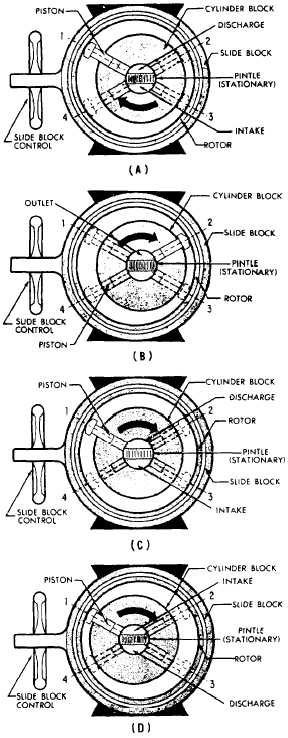Radial Piston Pumps
Figure 4-11 illustrates the operation of the
radial piston pump. The pump consists of a pintle,
which remains stationary and acts as a valve; a
Figure 4-11.—Principles of operation of the radial piston
pump.
cylinder block, which revolves around the pintle
and contains the cylinders in which the pistons
operate; a rotor, which houses the reaction ring
of hardened steel against which the piston heads
press; and a slide block, which is used to control
the length of the piston strokes. The slide block
does not revolve but houses and supports the
rotor, which does revolve due to the friction set
up by the sliding action between the piston heads
and the reaction ring. The cylinder block is
attached to the drive shaft.
Referring to view A of figure 4-11, assume that
space X in one of the cylinders of the cylinder
block contains liquid and that the respective piston
of this cylinder is at position 1. When the cylinder
block and piston are rotated in a clockwise
direction, the piston is forced into its cylinder as
it approaches position 2. This action reduces the
volumetric size of the cylinder and forces a
quantity of liquid out of the cylinder and into the
outlet port above the pintle. This pumping action
is due to the rotor being off-center in relation to
the center of the cylinder block.
In figure 4-11 view B, the piston has reached
position 2 and has forced the liquid out of the
open end of the cylinder through the outlet above
the pintle and into the system. While the piston
moves from position 2 to position 3, the open end
of the cylinder passes over the solid part of the
pintle; therefore, there is no intake or discharge
of liquid during this time. As the piston and
cylinder move from position 3 to position 4,
centrifugal force causes the piston to move
outward against the reaction ring of the rotor.
During this time the open end of the cylinder is
open to the intake side of the pintle and, therefore,
fills with liquid. As the piston moves from
position 4 to position 1, the open end of the
cylinder is against the solid side of the pintle and
no intake or discharge of liquid takes place. After
the piston has passed the pintle and starts toward
position 2, another discharge of liquid takes place.
Alternate intake and discharge continues as the
rotor revolves about its axis-intake on one side
of the pintle and discharge on the other, as the
piston slides in and out.
Notice in views A and B of figure 4-11 that
the center point of the rotor is different from the
center point of the cylinder block. The difference
of these centers produces the pumping action. If
the rotor is moved so that its center point is the
same as that of the cylinder block, as shown in
figure 4-11, view C, there is no pumping action,
since the piston does not move back and forth in
the cylinder as it rotates with the cylinder block.
4-10


